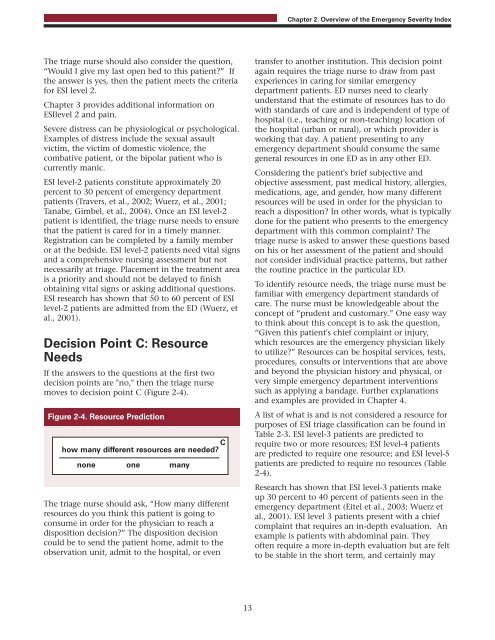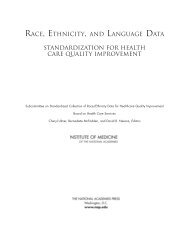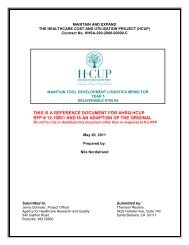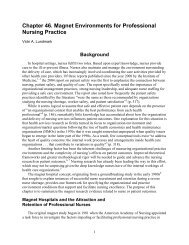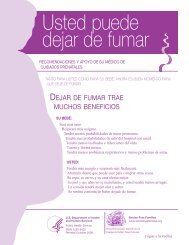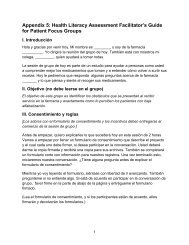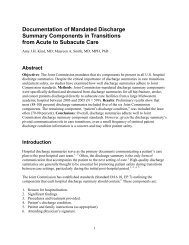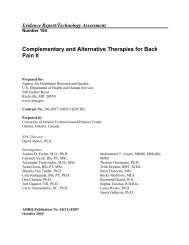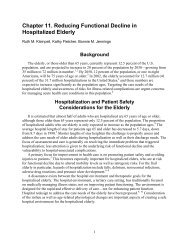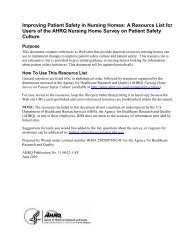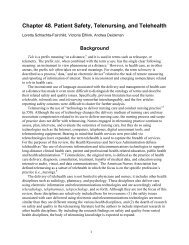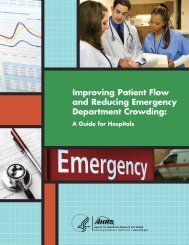Emergency Severity Index (ESI): A Triage Tool for Emergency ...
Emergency Severity Index (ESI): A Triage Tool for Emergency ...
Emergency Severity Index (ESI): A Triage Tool for Emergency ...
Create successful ePaper yourself
Turn your PDF publications into a flip-book with our unique Google optimized e-Paper software.
The triage nurse should also consider the question,<br />
“Would I give my last open bed to this patient?” If<br />
the answer is yes, then the patient meets the criteria<br />
<strong>for</strong> <strong>ESI</strong> level 2.<br />
Chapter 3 provides additional in<strong>for</strong>mation on<br />
<strong>ESI</strong>level 2 and pain.<br />
Severe distress can be physiological or psychological.<br />
Examples of distress include the sexual assault<br />
victim, the victim of domestic violence, the<br />
combative patient, or the bipolar patient who is<br />
currently manic.<br />
<strong>ESI</strong> level-2 patients constitute approximately 20<br />
percent to 30 percent of emergency department<br />
patients (Travers, et al., 2002; Wuerz, et al., 2001;<br />
Tanabe, Gimbel, et al., 2004). Once an <strong>ESI</strong> level-2<br />
patient is identified, the triage nurse needs to ensure<br />
that the patient is cared <strong>for</strong> in a timely manner.<br />
Registration can be completed by a family member<br />
or at the bedside. <strong>ESI</strong> level-2 patients need vital signs<br />
and a comprehensive nursing assessment but not<br />
necessarily at triage. Placement in the treatment area<br />
is a priority and should not be delayed to finish<br />
obtaining vital signs or asking additional questions.<br />
<strong>ESI</strong> research has shown that 50 to 60 percent of <strong>ESI</strong><br />
level-2 patients are admitted from the ED (Wuerz, et<br />
al., 2001).<br />
Decision Point C: Resource<br />
Needs<br />
If the answers to the questions at the first two<br />
decision points are "no," then the triage nurse<br />
moves to decision point C (Figure 2-4).<br />
Figure 2-4. Resource Prediction<br />
The triage nurse should ask, “How many different<br />
resources do you think this patient is going to<br />
consume in order <strong>for</strong> the physician to reach a<br />
disposition decision?” The disposition decision<br />
could be to send the patient home, admit to the<br />
observation unit, admit to the hospital, or even<br />
13<br />
Chapter 2. Overview of the <strong>Emergency</strong> <strong>Severity</strong> <strong>Index</strong><br />
transfer to another institution. This decision point<br />
again requires the triage nurse to draw from past<br />
experiences in caring <strong>for</strong> similar emergency<br />
department patients. ED nurses need to clearly<br />
understand that the estimate of resources has to do<br />
with standards of care and is independent of type of<br />
hospital (i.e., teaching or non-teaching) location of<br />
the hospital (urban or rural), or which provider is<br />
working that day. A patient presenting to any<br />
emergency department should consume the same<br />
general resources in one ED as in any other ED.<br />
Considering the patient's brief subjective and<br />
objective assessment, past medical history, allergies,<br />
medications, age, and gender, how many different<br />
resources will be used in order <strong>for</strong> the physician to<br />
reach a disposition? In other words, what is typically<br />
done <strong>for</strong> the patient who presents to the emergency<br />
department with this common complaint? The<br />
triage nurse is asked to answer these questions based<br />
on his or her assessment of the patient and should<br />
not consider individual practice patterns, but rather<br />
the routine practice in the particular ED.<br />
To identify resource needs, the triage nurse must be<br />
familiar with emergency department standards of<br />
care. The nurse must be knowledgeable about the<br />
concept of “prudent and customary.” One easy way<br />
to think about this concept is to ask the question,<br />
“Given this patient's chief complaint or injury,<br />
which resources are the emergency physician likely<br />
to utilize?” Resources can be hospital services, tests,<br />
procedures, consults or interventions that are above<br />
and beyond the physician history and physical, or<br />
very simple emergency department interventions<br />
such as applying a bandage. Further explanations<br />
and examples are provided in Chapter 4.<br />
A list of what is and is not considered a resource <strong>for</strong><br />
purposes of <strong>ESI</strong> triage classification can be found in<br />
Table 2-3. <strong>ESI</strong> level-3 patients are predicted to<br />
require two or more resources; <strong>ESI</strong> level-4 patients<br />
are predicted to require one resource; and <strong>ESI</strong> level-5<br />
patients are predicted to require no resources (Table<br />
2-4).<br />
Research has shown that <strong>ESI</strong> level-3 patients make<br />
up 30 percent to 40 percent of patients seen in the<br />
emergency department (Eitel et al., 2003; Wuerz et<br />
al., 2001). <strong>ESI</strong> level 3 patients present with a chief<br />
complaint that requires an in-depth evaluation. An<br />
example is patients with abdominal pain. They<br />
often require a more in-depth evaluation but are felt<br />
to be stable in the short term, and certainly may


